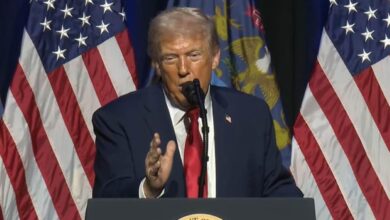What Is the “Volcker Effect” and How Can It Impact Latin America?
On the subject of the FED rate hike, we analyze the risks for Latin America with the Volcker era still in mind .

Photo: Paulo JC Nogueira, uscourts.gov
LatinAmerican Post | Luis Angel Hernández Liborio
Listen to this article
Leer en español: ¿Qué es el “efecto Volcker” y por qué el reciente anuncio de la FED puede impactar en Latinoamérica?
When the pandemic began in 2020, experts predicted an unflattering economic scenario, as the different sectors of the global economy would be affected. Low growth and rising inflation in the United States have taken their toll on the entire world, including Latin America. The North Americans have tried to contain inflation by increasing Fed interest rates, a fact that is causing anxiety in Latin America, which fears a new "Volcker effect."
Latin America already knows the recipe of the FED
Inflation in the main economies of Latin America has remained on the rise so far this year, with Brazil with an annual rate of 8.73% and Mexico with 8.70%. Its inflation level is below that of Europe, where the United Kingdom averages 9.9% per year and the European Union 9.1%, although at the same time Latin American economies have higher inflation than the United States, which averages 8.3 %, according to central bank data. Meanwhile, economies such as those of Venezuela (114.1%) and Argentina (78.5%) are sensitive to FED rate increases.
Despite registering the worst numbers in decades, the Latin American economies could be considered prepared for any change in the FED, the experience of the Volcker era has "vaccinated" these economies before this already known recipe. In the 1980s, the FED, headed by Paul Volcker, used the institution's rate as a weapon to combat inflation in the United States, which in the short term prevented its growth, but which in the medium and long term devastated the Latin American economies. mainly due to the fall in the prices of raw materials, of which the region is one of the main suppliers. The worst was not that, the situation worsened when the rates increased, the debts of the Latin American countries also did so, generating the so-called "debt crisis" in the region that collapsed the industries. At that time, the FED rate went from 3% in 1972 to 19% in 1981, which led to inflation reaching a "successful" 2.5%, which for the world, and mainly Latin America, turned out to be not very pleasant.
The debts of Latin America lurking
In the 1980s, the level of indebtedness of Latin American countries was high, rising from $16 billion in 1970 to $243 billion in 1980, according to data from the Complutense University of Madrid. With the debt crisis, this figure doubled throughout the decade, the so-called "lost decade" since the countries of the region began their recovery until the 1990s, albeit unevenly after the 1994 crises in Mexico and the 2001 crises in Argentina, Brazil, Argentina, Mexico, Peru, and Venezuela accounted for most of the regional debt, 80%.
In 2021, the most indebted countries are the Central American ones, while Mexico and Brazil are in the last places with 45% and 39% of debt with respect to the Gross National Product, according to information from the Bloomberg agency. In this list, Argentina is the South American country with a debt that represents 68% of its GNP. Given an escalation in the rate of the FED, the Argentine debt can unleash a new crisis, this has been one of the most sensitive issues in the country in the last two decades, almost reaching default and about to receive severe international sanctions. The case of Venezuela is extreme, inflation out of control, zero growth, and economic isolation would only worsen with higher rates, since it could have a direct effect on oil prices.
You can also read: Why Is There a Fear of a New Real Estate Bubble?
The risks of the FED rate hike
The direct risks of the Fed raising rates can be traced back to the lost decade: rising unemployment and recession are the costs of forced inflation reduction, although dollar appreciation would seem beneficial at first, this could bring again a fall in the prices of raw materials, reducing the purchasing power of the economies of the region that could hardly control their inflation and even face the payment of debt. Argentina is one of the clearest recent examples.
The outflow of capital due to the attractive rates of the FED would leave the Latin American productive sector in decline, which would reduce the purchasing power of citizens and companies, a fact aggravated by unemployment and rising inflation. Of course, it is a catastrophic prospect based on the experience of the 1980s. However, current conditions are not far from those of that time, the debt of Latin American countries is still high considering the proportion with respect to the GNP of each nation. The productive sector continues to be linked to raw materials and fuels, mainly in Brazil, Mexico, with oil, and Argentina, with cereals and meat.
Hope for the region
Despite the concern of the central banks of Latin America, there is a notable difference with respect to Volcker's administration in the 1980s: the US economy has serious structural problems that make it vulnerable to itself. This means that, just like almost 40 years ago, unemployment levels could worsen, the supply of credit would be affected, and with it consumption, in addition to low wages. Finally, according to information from the Elcano Royal Institute of Spain, the US economy had debt equivalent to 100% of its GDP in the 1980s, while today it is 220%, so raising interest rates on the FED without apparent control could trigger an unprecedented crisis in a context of economic weakness and war. This gives hope to Latin America, which expects high-interest rates from the Fed but at a level that the United States can control without the need to drastically reduce inflation as they did in the Volcker era.




